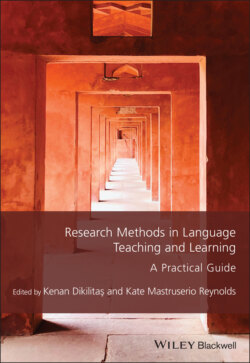Читать книгу Research Methods in Language Teaching and Learning - Группа авторов - Страница 29
Introduction Contextualizing the Research
ОглавлениеThe classroom, notes Wright, “is the true centre of educational experience … it is here, through the teaching-and-learning process, that education ‘happens’” (2005, p. 1). And, although the work of an English language teacher comprises many elements and activities – for example, lesson preparation, training and continuing professional development, setting and marking assessments, developing materials, and report writing – the classroom is, for most, “the crucible” of our professional lives (Gaies, 1980).
This was certainly true for myself as I started out as an English language teacher in the early 1990s. Yet it was soon evident that the care with which I planned my lessons, carefully trying to anticipate potential pitfalls and problems in order that a session’s aims and objectives could be achieved and language could be learned, did not relate in straightforward ways to what happened in the classroom. For example, teaching the same or similar material to two different classes would often lead to differences in the way the learners engaged with the lesson content and with each other in class, and in the language they seemed to remember and/or learn; some classes seemed to go well, some less so. And even after significant reflection, I often could not quite understand why this was.
Of course, every teacher encounters similar issues, of why some lessons “work” but others do not; “common sense” tells us that this is just part of the life of a teacher. However, it was while studying for an MA in English language teaching (ELT) at Lancaster University a few years into my teaching career that I first encountered ideas and conceptualizations of the language classroom that started to make sense of it all. Not only is the classroom a place (either physical or online) where “typically, one teacher and a number of learners come together for a pedagogical purpose” (Allwright, 1992, p. 267; emphasis added), classrooms are also social environments (Tudor, 2001). From this perspective, classrooms have their own complex social cultures (Breen, 2001), which are shaped by, and shape, teachers and learners. A language class is thus:
… an arena of subjective and intersubjective realities which are worked out, changed and maintained. And these realities are not trivial background to the tasks of teaching and learning a language … they continually specify and mould the activities of teaching and learning(ibid., p. 128)
For example, teachers and learners come to class with particular ideas as to what is and is not a “proper lesson.” These include views about classroom pedagogy, for instance, what constitutes a useful focus for a lesson or what is an effective learning activity. But they also include perspectives about what are and are not appropriate ways for teachers and learners to behave and interact with each other in class (Hall, 2017; van Lier, 1988). Shaping the ways in which teachers and learners attribute reasons to other classroom participants’ behavior, and their own subsequent actions and reactions, such perspectives are also influenced by the expectations and demands of the school or institution the classroom is part of, and by society at large (van Lier, 1988). From this standpoint, therefore, classrooms and classroom events are socially constructed. And given the number of participants who in some way affect what happens in a class, every language classroom is both unique and complex (Tudor, 2001), consequently making classroom language teaching and learning “messy” (Freeman, 1996, p. 103).
Yet while this way of thinking about classrooms starts to explain the complexities of classroom life in broad terms, if teachers and researchers are to understand the social processes which underpin and contribute to teaching and learning in more detail, we need to see how this “messiness” plays out in practice, in particular language classrooms. This chapter, therefore, documents my own attempt to explore how a specific classroom was socially constructed. It focuses in particular on the principles underpinning and possibilities for my research methodology, and the subsequent decisions I made about the research design and its implementation. As with any research project, implementing the study effectively was not without its challenges.
